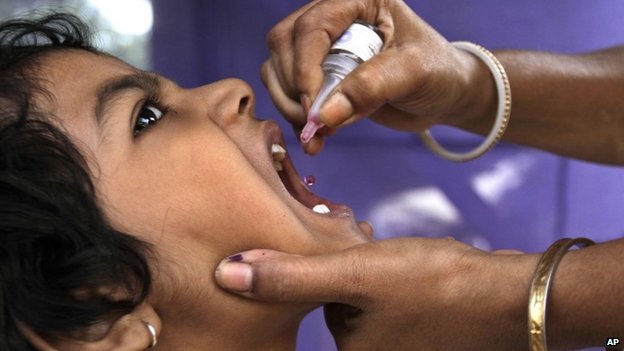
In 1988, the Global Polio Eradication Initiative was launched in collaboration with World Health Organization (WHO), Center for Disease Control and Prevention (CDC), United Nations International Children's Emergency Fund (UNICEF) and the governments of all major nations with a sole motive of worldwide eradication of Polio. During the late 1980s, the wild Poliovirus was endemic in 125 countries, paralyzing more than 1000* children every day. Each year, there were nearly 3, 50,000* new cases of children being infected with the wild poliovirus worldwide. Since then, the number of infections has now come down to 99%, according to the reports of WHO.
Polio is a highly infectious and contagious viral disease which invades the nervous system resulting in permanent paralysis. Children under the age of five are vulnerable to this deadly virus, with the newborns being the most affected. Poliomyelitis, the virus which causes polio, usually dwells in the throat and intestinal tracts of humans. Being a contagious disease, the virus enters the body through the mouth and multiplies within the intestine which are then spread to the environment through the feces of the infected person.

These viruses spread rapidly to other people, especially among those living in poor hygienic conditions where proper sanitation is a scarcity. Polio can even spread when edible food or drink gets contaminated by the infected feces while few evidences suggest that flies passively transfer poliovirus from feces to food. In most cases, victims experience no symptoms or very mild symptoms which generally go unnoticed. The initial symptoms usually include fever, fatigue, headache, vomiting, and stiffness in the neck and severe pain in the limbs.
The majority of the infections develop into irreversible paralysis, usually in the limbs. On multiplying, these deadly viruses tend to impair the nerve cells which activate the muscles. With the lack of stimulating nerve cells, these affected muscles cease to be functional and the corresponding limb becomes lifeless leading to a condition known as acute flaccid paralysis (AFP). In severe cases, it attacks the nerve cells of the brain stem giving rise to breathing, swallowing, and speaking problems.
There is a remote chance of premature death as a result of immobilized breathing muscles. With children being the primary victim of this life-crippling disease, their future gets drastically hampered by paralysis, induced by poliovirus.Being an incurable disease, proper immunization through vaccination is the only way to prevent Polio. There are two types of vaccine that offer protection against polio: inactivated poliovirus vaccine (IPV) and oral poliovirus vaccine (OPV). IPV is usually administered in injection form to the limbs while OPV is consumed orally as the name suggests.
Ideally, childhood is the apt time to get vaccinated for immunization from poliovirus. A child must be administered 4 dosages of IPV before the age of 5 while adults can get themselves vaccinated with a booster dose at any age.In a bid to eradicate polio, the Global Polio Eradication Initiative was launched worldwide with all the infected nations adopting the Polio Immunization Programme which stressed on immunizing people of all ages. Strengthening routine immunization, detecting the infected victims, increasing disease surveillance, and mop-up immunization were the key strategies followed by the Polio Immunization Programme.

India was considered as the toughest place in the world to eradicate Polio with nearly 1, 50,000** cases being reported each year. In India, during each National Immunization Day (NID), 2.3 million** vaccinators under the direction of 1,55,000 supervisors, visited 209 million houses to administer Oral Polio Vaccine to around 172 million** children under the age of 5 across the country.
The undeterred spirit of the people coupled with the government’s dedicated programme, left India with only 42 cases across the country in 2010**, marking a 98% decline in the polio cases. On 13th Jan 2016, India celebrated 5 years of being a Polio-free country. The last case of polio in the country was reported from Howrah district in West Bengal on January 13, 2011**. Manipal Hospitals through their various polio awareness initiatives taken over the past decades, relinquished their part of contribution towards the eradication of polio in India.
With polio being now rampant only in two countries - Afghanistan and Pakistan***, it has been eradicated from rest of the world which involved tedious hard work and dedication of all major health organization and welfare communities. In years to come, Polio will surely be an issue of past with it being eradicated from the world very soon
Courtesy by www.businesswire.com




